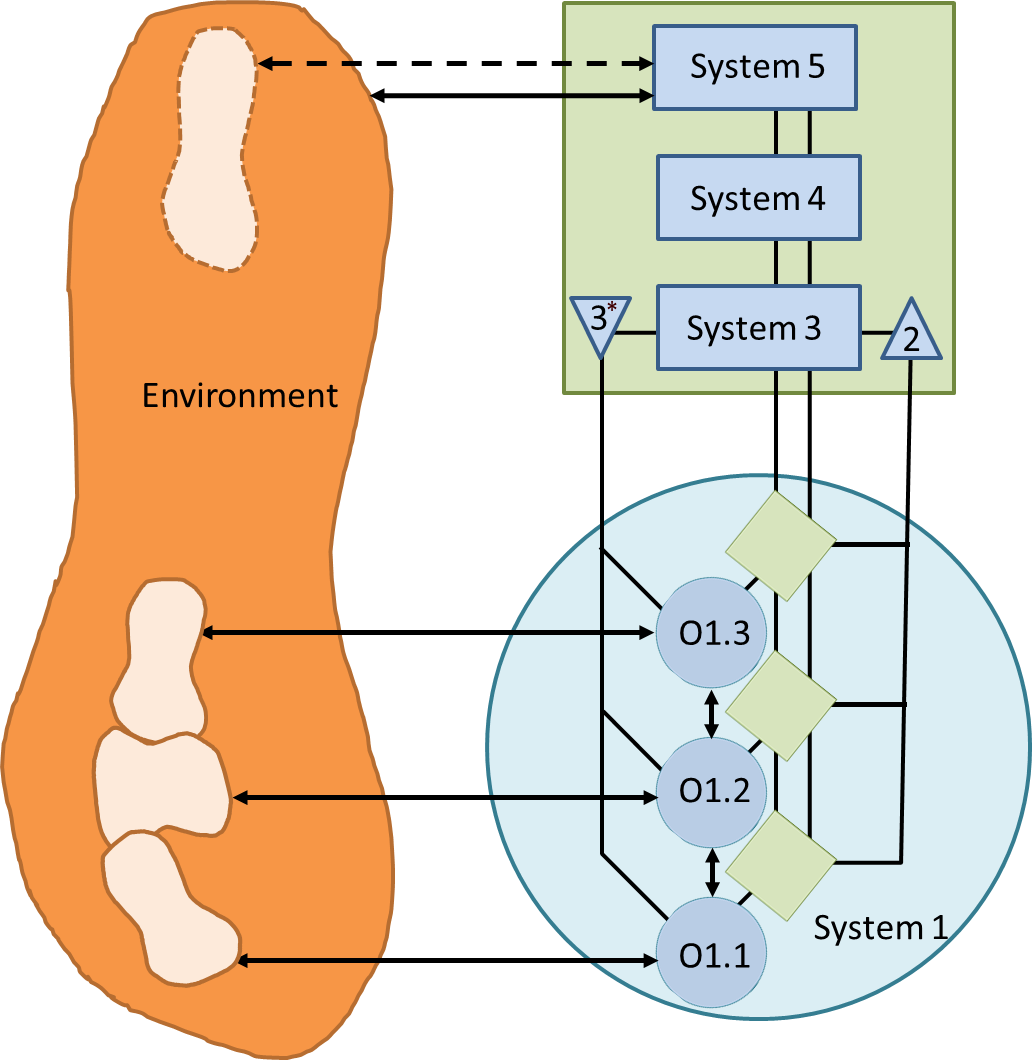In very simplistic terms, System 4 is concerned with “research and design” or the combination of looking at the environment and future gazing with communicating adjustments within the system to accommodate this. Indeed Stafford Beer described System 4 as “the big switch”. System 5 is the part that decides what the policy is going to be – as we’ll see in the next part. But for now we’ll concentrate on System 4.
The role of System 4: The “big switch”
The diagram I’ve been using (repeated here for convenience – click to enlarge) shows that system 5 is connected to the environment. Strictly speaking, it’s actually system 4 that has the direct connection, but I wanted to convey that fact that system 5 needs to be aware of the environment to do its job properly (I’ll touch on that in the next part).So far in this series I have avoided quoting Stafford Beer directly because his language is sometimes technical, and his explanations necessarily detailed and long. However I think he describes the function of system 4 pretty succinctly. In Brain of the Firm he writes:
We have set up the three-tier autonomic system intended to maintain a homeostatic internal balance, and even to optimize performance within an accepted framework and under established criteria. The successful operation of that autonomic system is dependent … on a steady stream of appropriate instructions descending … from System Five. The environment for decision at this top level … includes representation of the autonomic condition, together with filtered information … Both sorts of input into System Five … are switched by System Four. … [A] second major component of input to top-level decisions: information about the environment set by the outside world … [is] collected by System Four … and … switched into System 5. (Chapter 13, p. 181)
System 4 responsibilities
This means that System 4 is responsible for:- Keeping tabs on what’s going on in the external environment at a meta level - e.g. what kinds of things are coming up in the future that might require a change in direction;
- Ensuring system 3 is aware of and reacting appropriately to the environmental changes;
- Filtering this as appropriate for communication to System 5.
System 4 in projects
In PRINCE2 terms the Senior User and Senior Supplier roles are key system 4 components.Senior User role:
The Senior User (working with and through the Project Manager) ensures that needs of the business are properly reflected. For example, if the business areas involved with the project are over stretched in terms of resources, it’s the role of the Senior User to reflect on the issue, provide potential solutions and bring them to the Board. It’s also part of their role to ensure that the business actually does what the project requires. More importantly, the Senior User should be aware of the future plans for his/her services and what is being done to keep pace with external demands and changes. This needs to be fed into the project both in terms of constraints and scope review.Senior Supplier role:
Traditionally the supplier role is seen as implementing the chosen technical solution. (NB the supplier may be internal, external or a mixture of both). The VSM model throws a different light on the role. It’s more one of making sure the right technical solution is chosen! This is not necessary a one-off decision: in large, long-term projects, the environment and business may change, so the solution may need to change too. So the role includes not only coming up with the proposed solutions, but continually horizon scanning to make sure they stay relevant.VSM lessons
So far in this series the VSM lessons have been to highlight things we know in our heart of hearts should be done, but which aren’t always done sufficiently well. Here, for the first time, VSM is – I think – drawing our attention to an area where projects often are completely lacking. Both the Senior User and the Senior Supplier roles have critical impact on ensuring a project remains properly aligned with the environment. This is especially the case for big, long-term change projects.These two roles are critical to the success of projects because they are the health checks, if you like. Through them the Project Board is aware of how well the project (system) is performing in terms of meeting internal business needs and taking due note of the external environment. Personally I have almost never seen this being done adeqautely. If we don’t do it, the system (project) will not be viable.
For example, you might successfully deliver a working product, but its output is no longer what the business needs to provide!
The next installment will look at the final system: System 5, the policy maker.

No comments:
Post a Comment